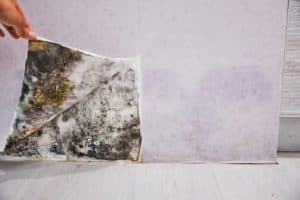When the day comes that you can finally close on your new home it is so exciting. After all the papers are signed and the moving trucks are ordered it seems that everything is good to go. It may be as early as the move-in day or a few days afterward that you discover a problem. It could be a smell that is not right that draws your attention or you spot something on the wall in the basement you haven’t seen before when visiting. It’s a discovery that every homeowner dreads; you’ve found mold in your new home.
This scenario occurs more often than you think. No one ever imagines they’re buying a house with mold problems. There is an expectation that the home inspection process will uncover potential problems, but many inspectors don’t check for that issue. And even newly built homes can have hidden mold.
What is Mold?

Mold is a type of fungus that grows on plants, wood, fabric, food, and any other organic material. Basically, mold is a natural recycler of dead organic matter. It is a natural occurrence of nature but when it grows in or on surfaces indoors, it can cause health and structural issues.
The mold spores themselves are not harmful and don’t cause mold to grow. However, if they find moisture, the mold fungus will begin to grow and continue to emit spores throughout the area and multiply if the moisture is not remediated immediately. It only takes as little as 48 hours for mold to start growing on unattended moist or damp surfaces.
Health Risks and Damages Caused from Mold Exposure
If mold is growing indoors, it can cause a slew of health issues. The severity and extent of health issues depend, in large part, on the type of mold. Black toxic mold is the worst! People who are exposed can suffer from a variety of ailments. These include respiratory problems, headaches, skin irritation, and infections.
The bottom line is that untreated mold growth, especially indoors, will negatively impact the health and well-being of those who live in the environment. It’s important to get all mold removed and the area remediated to restore the home to a healthy environment.
Mold can affect various types of furnishings in your home or workplace, as well as the building structure itself. Some materials are more susceptible to mold than others and removal and restoration will vary depending on the material. Some materials cannot be cleaned and will need to be replaced; for example, it’s impossible to remove mold from drywall. Surfaces where mold will likely grow include wood, concrete, drywall, and paper. It can grow deep into carpeting, furniture, and drapes as well.
Actions to Take if You Find Mold in Your Home
1. Identify the Type of Mold
It’s important to know exactly what type of mold you’re up against. There are DIY test kits available that identify different types, however, If you have any ongoing health issues, it’s safer to leave testing to a certified mold removal company.
2. Determine Who Is Liable
Chances are that your seller didn’t disclose a mold problem because they were unaware of it. The original home inspection that was done before purchasing the house, should have noted signs of leaks or mold. Therefore it is recommended to hire a second inspector to confirm and document mold growth and damages that were originally overlooked. If you have reason to believe the seller knew of the mold, then it may be time to talk with an attorney to discuss liability and how to move forward.
3. Contact the Seller
Reach out to the seller and make them aware of the situation. Discuss with them about paying for the necessary repairs if there are any, as well as mold removal and remediation. If they are unwilling to work with you then an attorney can draw up a demand letter detailing the problem and the reasons you believe the seller should assume responsibility. There are many ways to approach the seller that can produce a positive resolution outside the court system.
4. Mold Removal and Remediation
Removal and Remediation of the mold must be a priority. You may be able to effectively remove small amounts of mold yourself, if visible and on solid surfaces. You can purchase a mold test kit to check for mold growth.
Keep in mind that this DIY method only works if the mold is visible and on solid surfaces. If mold is growing on porous surfaces, like carpeting or drywall, it cannot be effectively cleaned. These items may be damaged beyond remediation or need to be cleaned by a professional mold remediation expert.
Also If you do try to clean the mold yourself, beware of a persisting musty smell after you clean. That could mean mold is hiding where you can’t see it. Again, that will require the professionals to remediate the situation.
Hire a Professional Mold Remediation Company
If you suspect you have a mold problem, contact St. Louis Cleaning and Restoration immediately. We have the knowledge, expertise, and equipment to properly clean your home of mold and prevent it from recurring. We’ve been in the mold remediation business since 1991, providing service to homeowners and businesses.
Our technicians are highly trained and certified with The Institute of Inspection, Cleaning & Restoration (IICRC), which is a certification and Standards Developing Organization (SDO) non-profit organization for the inspection, cleaning, and restoration industries. This ensures you’ll receive the highest quality professional services possible.
As a local family-owned company, our mission is to exceed our client’s expectations and provide fair and honest pricing, quality service, innovative technology, and unprecedented customer service. We offer 24/7 emergency response service so we’re available when you need us.

